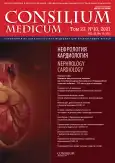Myocarditis: diagnosis and treatment in a period of pandemic
- Authors: Blagova O.V.1, Kogan E.A.1
-
Affiliations:
- Sechenov First Moscow State Medical University (Sechenov University)
- Issue: Vol 23, No 10 (2021)
- Pages: 742-749
- Section: Articles
- URL: https://journals.rcsi.science/2075-1753/article/view/96682
- DOI: https://doi.org/10.26442/20751753.2021.10.200668
- ID: 96682
Cite item
Full Text
Abstract
The novel coronavirus infection pandemic, officially declared in early 2020 and has been continuing till now, led to a significant increase in the rate of myocarditis, drew the attention of multi-discipline specialist to this problem and set new accents in it. In the acute phase of COVID-19, the rate of myocarditis in the most severe (dead) patients is estimated to be 7.2%, however, its real prevalence in different course of the disease is unknown; life-time diagnostics is complicated by the difficulties of transporting patients to expert centers for cardiac magnetic resonance imaging and endomyocardial biopsy. A troponin test is not sufficiently specific; chest pain, arrhythmias, and pericardial effusion are most common findings indicating heart damage (up to 20%). Cardiovascular signs and symptoms generally correlate with D-dimer levels and prognosis. In the acute phase of the disease, elevated anticardiac antibody titers are detected in almost 3/4 of patients, that reflect the systemic immune response and is one of the important mechanisms of heart damage. SARS-CoV-2 RNA is revealed in the myocardium both during COVID-19 and up to 6–8 months after it, that is accompanied by the morphological and clinical signs of subacute/chronic post-COVID myocarditis. Its main manifestations are arrhythmias and heart chamber dilation with impaired contractility. COVID-19 can lead to a significant worsening of symptoms of pre-existing myocarditis if there is no basic therapy, but in patients taking immunosuppressive therapy, its course is relatively favorable and usually does not lead to an exacerbation of myocarditis. A novel coronavirus (SARS-CoV-2) is an etiological factor not only for acute myocarditis in the initial (infectious) phase of the disease, but also for subacute (within 1 to 3 months) and chronic post-COVID myocarditis, which are due to not only the virus persistence in the myocardium, but, mainly, due to autoimmune reactions, which requires the determination of indications for immunosuppressive therapy, its volume and duration.
Full Text
##article.viewOnOriginalSite##About the authors
Olga V. Blagova
Sechenov First Moscow State Medical University (Sechenov University)
Author for correspondence.
Email: blagovao@mail.ru
ORCID iD: 0000-0002-5253-793X
D. Sci. (Med.), Prof., Sechenov First Moscow State Medical University (Sechenov University)
Russian Federation, MoscowEvgenyia A. Kogan
Sechenov First Moscow State Medical University (Sechenov University)
Email: blagovao@mail.ru
ORCID iD: 0000-0002-1107-3753
D. Sci. (Med.), Prof., Sechenov First Moscow State Medical University (Sechenov University)
Russian Federation, MoscowReferences
Supplementary files







